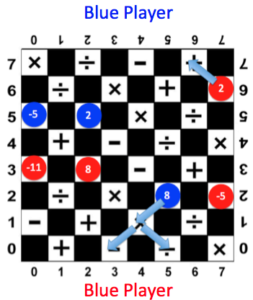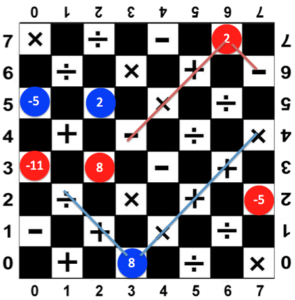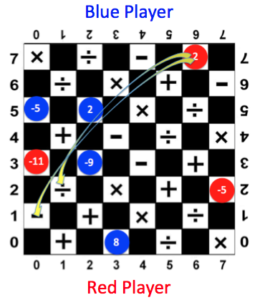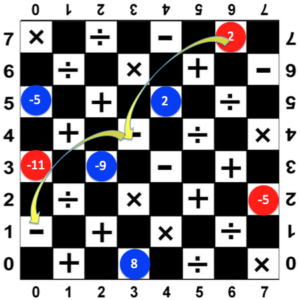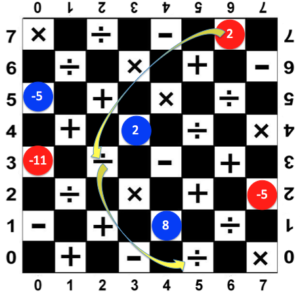Introduction to the DaMath Board Game Part 3
This is the third part of our series on learning how to play Damath. In the first part, we learned about the basics of Damath and in the second part, we learned how to capture multiple pieces.
The Dama Piece
A piece can be promoted when it reaches the last row (the first row of the opponent’s area) on the board. In the next figure, if it is the Red Player’s turn, then he can promote 2 by moving it to (6,7) as indicated by the arrow. In the same way, the Blue Player’s 8 is just two moves away from being promoted. Promoted pieces are called dama (roughly equivalent of Queen in chess). Each player can have more than one dama.
Moving the Dama
The dama can move forward and backward on unobstructed diagonals. For example, if the Red Player’s 2 becomes a dama on (6,7) as shown in the next figure, it can move to any of the four squares indicated by the red lines. It cannot move to (1,2) and (0,1) because 8 is obstructing the path.
Also, if the Blue Player’s 8 becomes a dama on (3,0), the Blue Player can move 8 to any of the six squares as indicated by the blue lines.
Capturing Opponent’s Pieces Using a Dama
The dama is a powerful piece because it can capture anything on its path. For example, in the next figure, the Red Player’s 2 (a dama) can capture -9 and choose whether to land on (1,2) or (0,1).
If a dama captures a piece, its score is doubled. In the figure above, if the Red Player captures -9 and lands on (0,1), then the score is [2 – (- 9)] × 2 = 22. If the Red Player lands on (1,2), the score is (2/(-9) × 2 = -4/9.
A dama can also capture multiple pieces. In the next figure, it is the Red Player’s turn and the dama can capture just 2, or he can capture 2 and -9 as shown by the arrows.
Here are the expressions and scores for the possible cases above:
Case 1: Red Player captures 2 and 9 and lands on (0,1): [2 – 2 – (-9)] × 2 = 18.
Case 2: Red Player captures 2 and 9 and lands on (1,2): 2[2 – 2 / (-9)] = 20/9.
Case 3: Red Player captures 2: 2 – 2 = 0.
In Case 3, after the Red Player’s move, the Blue player is required to capture the dama using -9, so the Blue Player’s score will be (-9)(2) × 2 = -36. So, among the three cases above, the third case is the best choice for the Red Player, deducting 36 from his opponent’s score.

In the next figure, if it is the Red Player’s move, he can choose to capture 2 or both 2 and 8. Which is the best move for the Red Player?
That’s it. That ends our post. In the next post, I am going to present the notation for Damath.
